
Author and Maps:
Brett Lucas
This article tells the story about the Thanksgiving meal. Typically, the Thanksgiving meal is often associated with foods that were available in the northeast United States, including items such as turkey, potatoes, squash, corn, green beans, cranberries, and pumpkin.
This article provides for a deeper dive into the regions of the United States where these foods are typically grown, based on recent data from the United States Department of Agriculture, that is gathered through the Census of Agriculture and other National Agricultural Statistics (https://quickstats.nass.usda.gov/).
Once "county" level data (animals and crops) was obtained from the USDA, it was brought into Excel to be cleaned up, state and county FIPS codes were joined, sorted via Pivot Tables, and then brought into Maptitude via a data join. Data was mapped at the county level (the most granular level available from the USDA), via graduated symbols to show the quantity of a crop.
From the USDA, Turkey data is available showing the number of head of turkey that are raised. According to USDA data and the National Turkey Federation, the top states for turkey production include Minnesota, North Carolina, South Carolina, Arkansas, Indiana, Missouri, Virginia, Iowa and California. This map also represents regions where many of the large agricultural corporations that grow and process turkeys are located today.
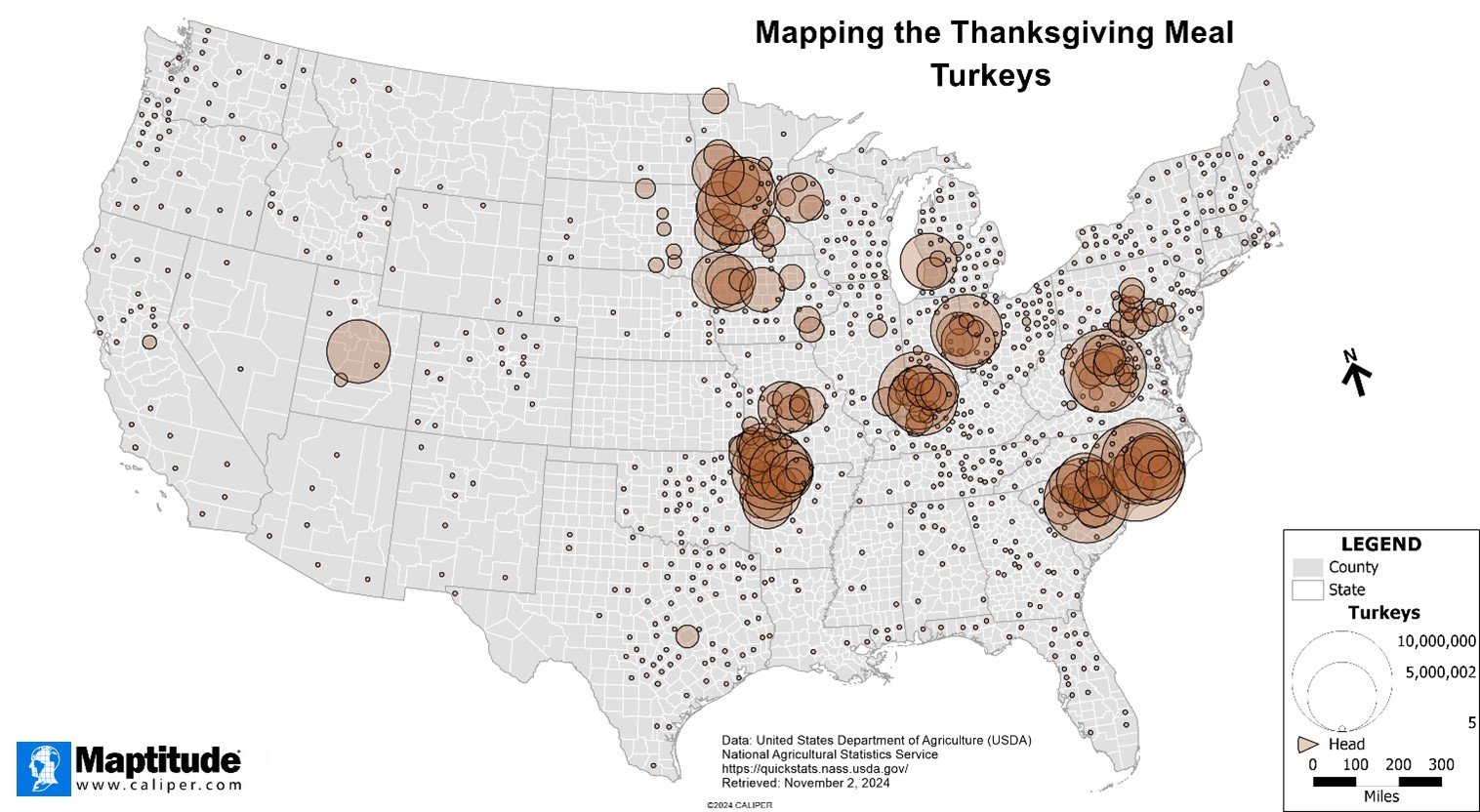
Most Americans have a love-hate relationship with Brussels sprouts. Brussels sprouts were introduced into the Americas by the French, with the early commercial plantings in the Louisiana delta. Over time, the coastal regions of California (San Mateo and Monterey Counties) became the primary growing region with a climate that was suitable (coastal fog and cool temperatures year-round). The map below shows where there are at least 5-acres of land devoted to Brussels sprout production.
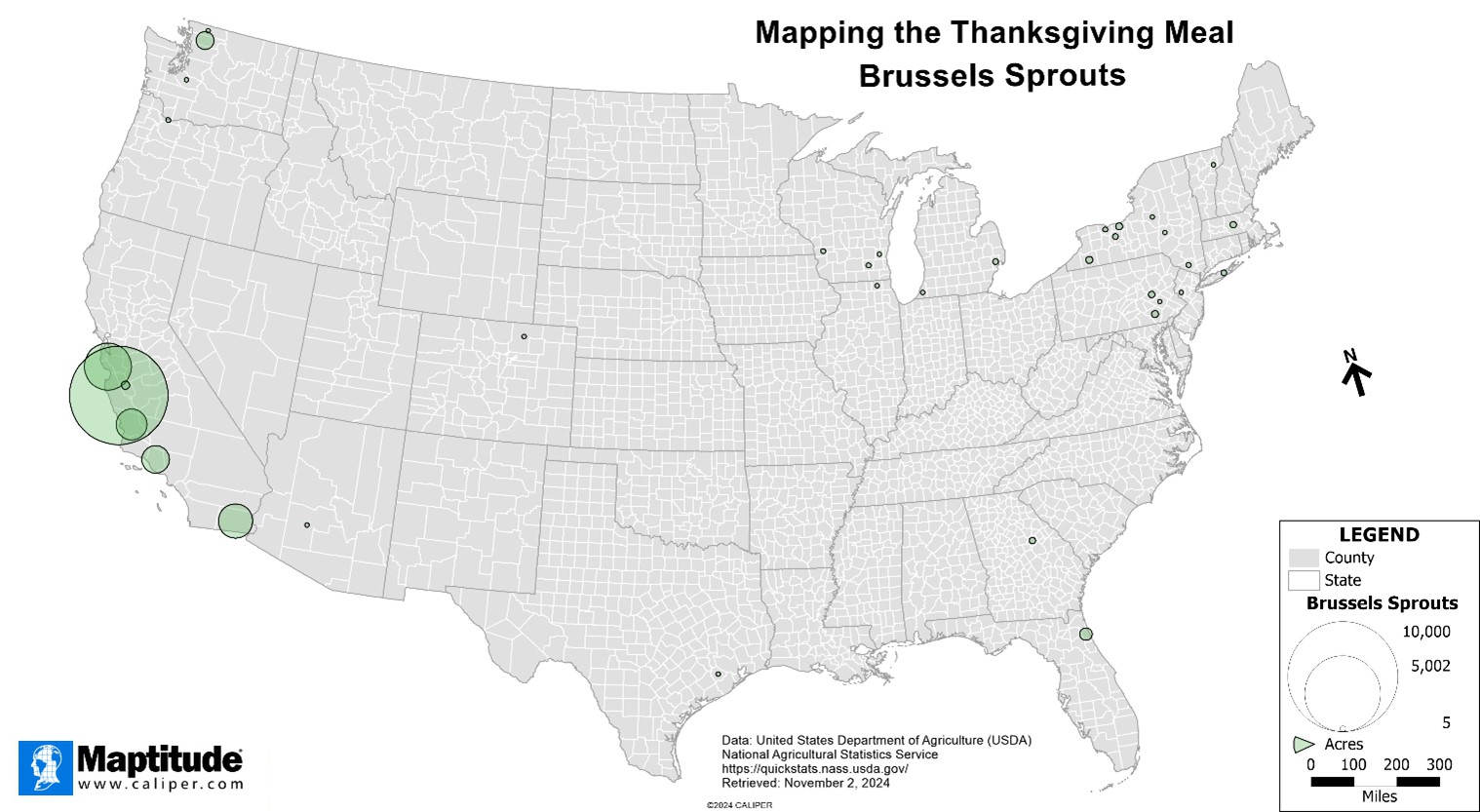
Cranberries were cultivated in the Cape Cod region of Massachusetts. The top states for cranberry production include Oregon, Washington, Massachusetts, and Wisconsin, with Wisconsin being the largest producer. Cranberries grow best in regions with a sandy soil, abundant fresh water, a dormancy period, a temperate climate, and full sun availability. The map below shows where there are at least 5-acres of land devoted to cranberry production.
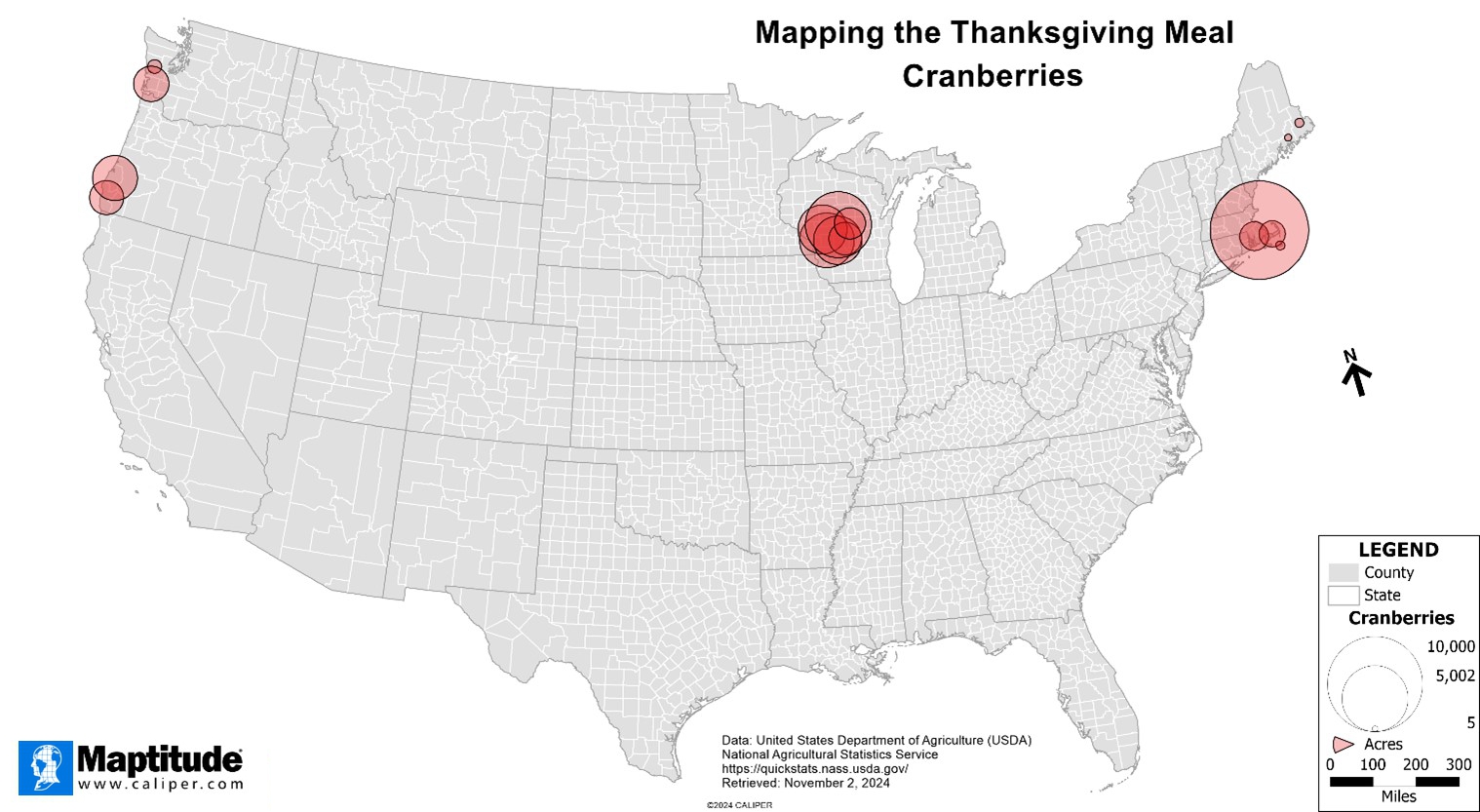
Green bean casserole is a staple of the Thanksgiving table. Green beans were originally marketed as an everyday side dish, though became popular for Thanksgiving dinners in the 1960's after Campbell's Soup placed the recipe on the can's label, and the dish morphed into a casserole. The top states for green bean production include California, Washington, Wisconsin, Delaware, North Carolina, South Carolina, and Florida. The map below shows where there are at least 5-acres of land devoted to green bean production.
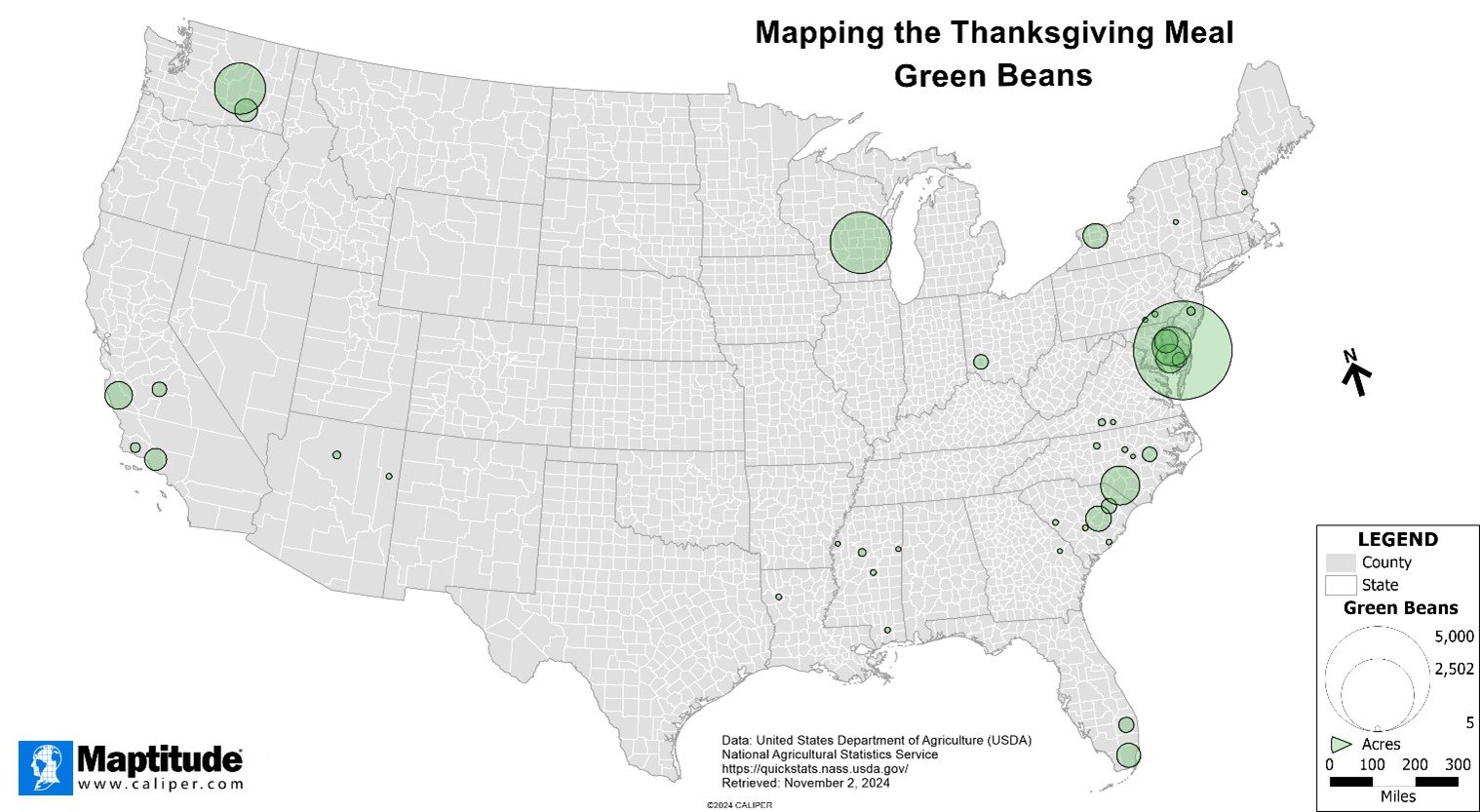
Green peas are often served as a side dish at the Thanksgiving table. Green peas grow best in regions with cool damp weather and moderate temperatures (55°F and 65°F). The top states for green pea production include California, Washington, Minnesota, Wisconsin, Michigan, and New York. The map below shows where there are at least 5-acres of land devoted to green pea production.
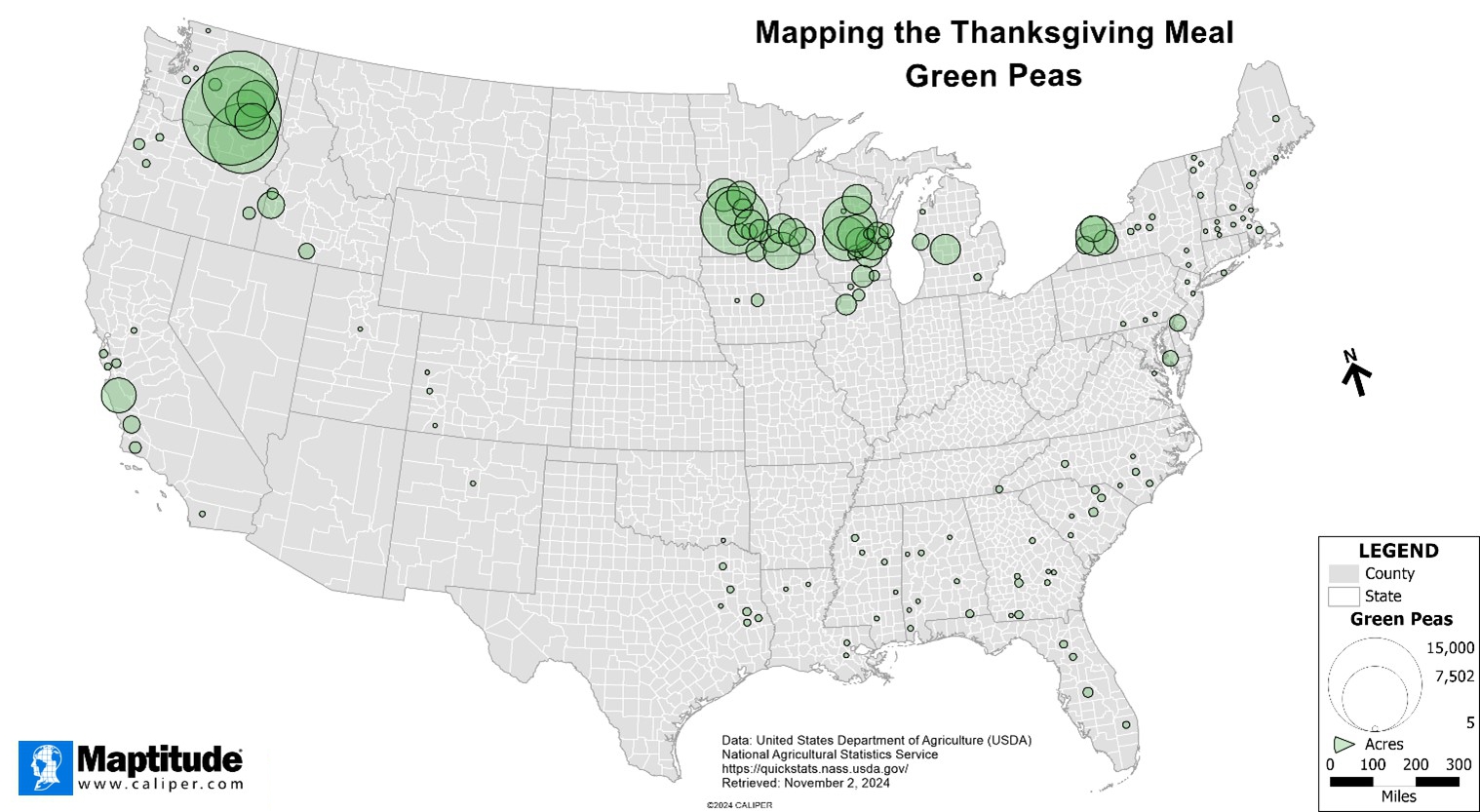
Pecans are a nut (seed) from pecan trees, that are used as a snack food as well as a part of Southern cuisine, including pecan pie. Along with pumpkin pie, pecan pie is a common dessert at the Thanksgiving table. Pecans grow best in regions with warm and humid climates. The top states for pecan production include New Mexico, Texas, Oklahoma, and Georgia, as well as other states in the southeastern United States. The map below shows where there are at least 5-acres of land devoted to pecan production.
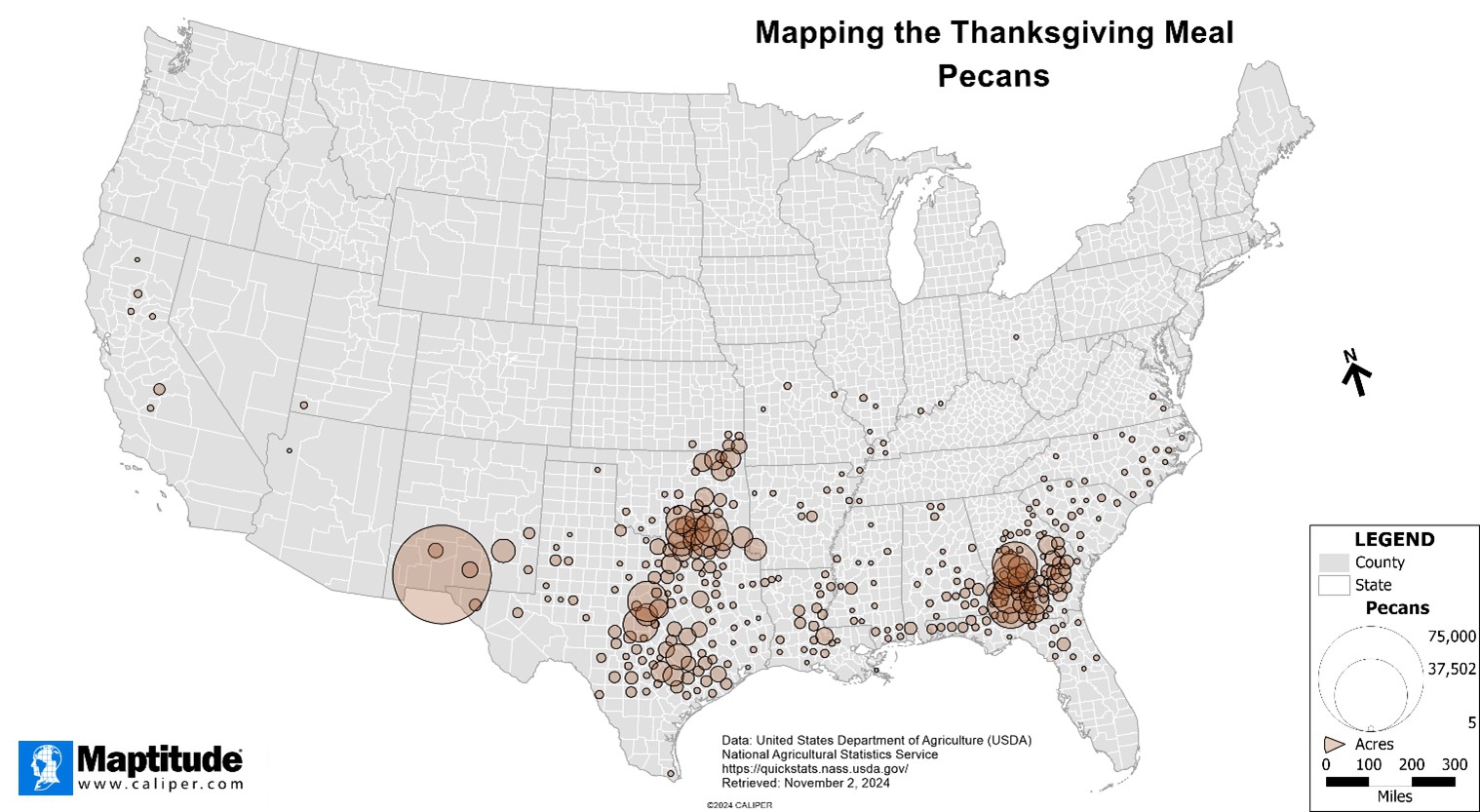
No Thanksgiving meal is complete without a heaping bowl of mashed potatoes. Potatoes (primarily russet potatoes), grow best in regions with moderately cool temperatures during the growing season. The top states for potato production include Idaho and Washington, as well as Minnesota, Wisconsin, and Michigan. The map below shows where there are at least 5-acres of land devoted to potato production.
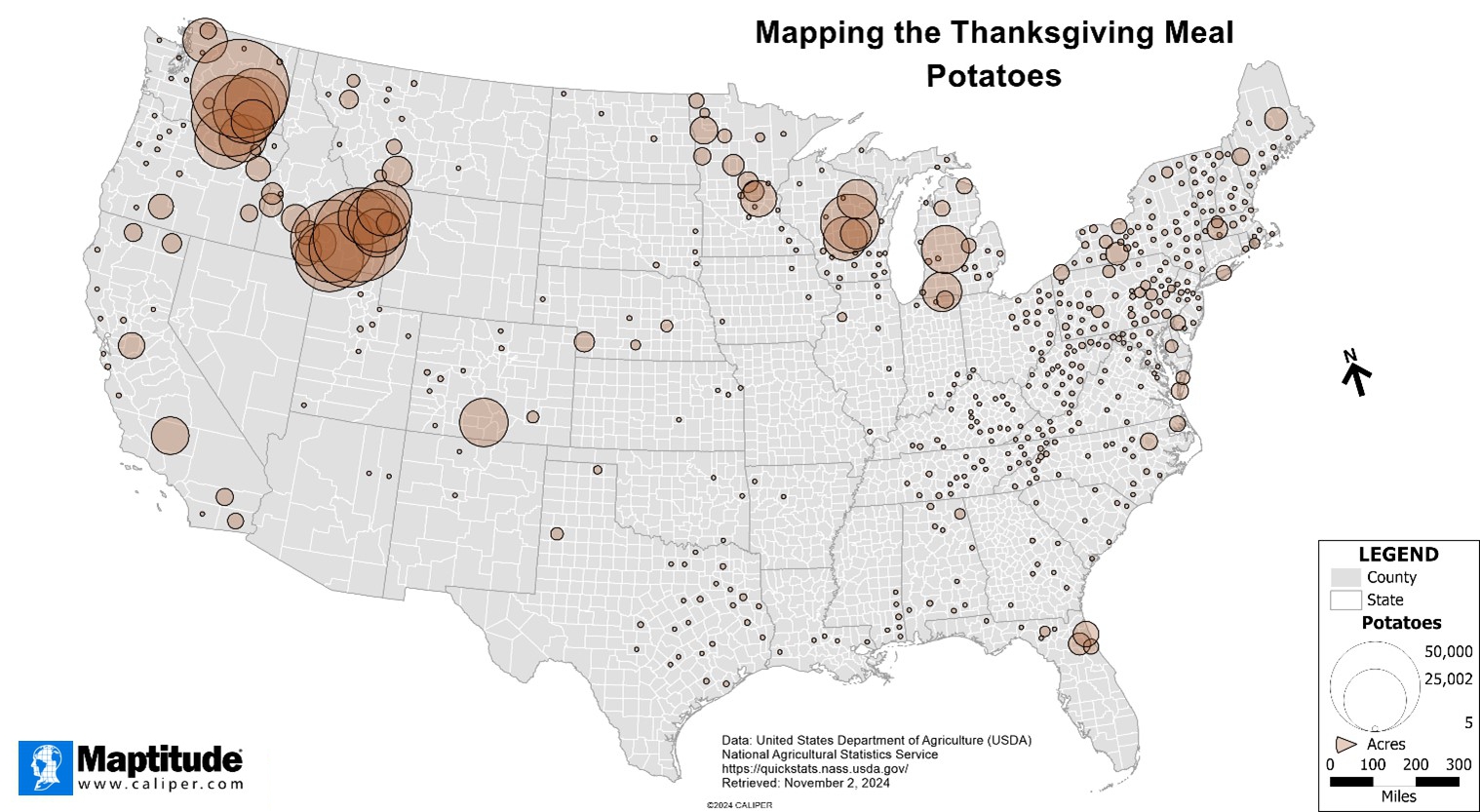
Pumpkins are associated with the fall harvest. The insides of the pumpkin were able to be pureed and formed the basis of pumpkin pie and squash side dishes. Pumpkins grow best in warm climates with lots of water and frost-free weather. The top states for pumpkin production include Illinois, Indiana, California, Michigan, Washington, Pennsylvania, North Carolina, Ohio, New York, Virgina, and Oregon. The map below shows where there are at least 5-acres of land devoted to pumpkin production.
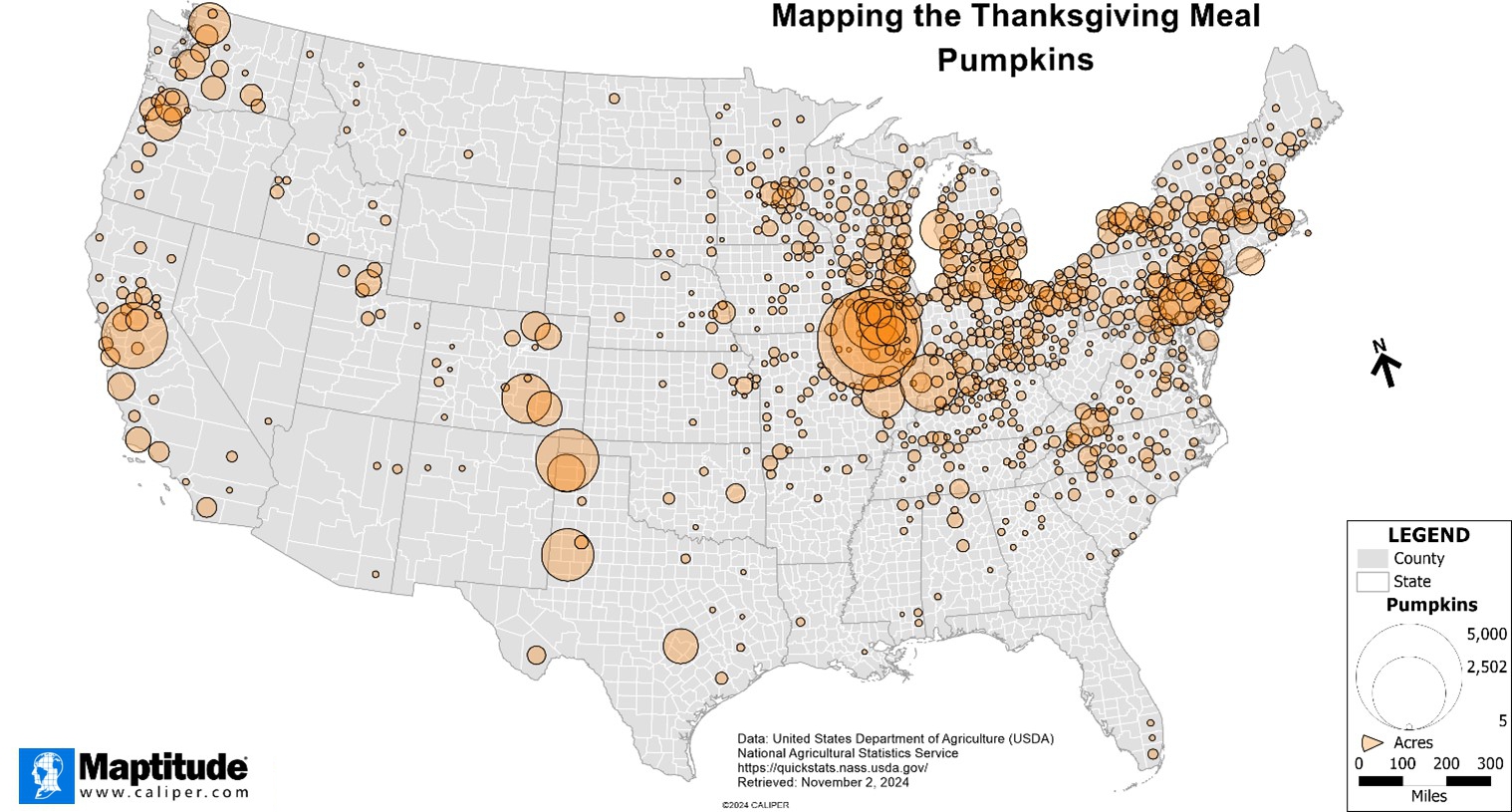
Historically, corn, when served as part of Thanksgiving meal, was more of a cornmeal mush sweetened with molasses. Sweet corn is associated with the fall harvest as the crop was abundant. Sweet corn grows best in climates with a cool soil temperature for germination, and then warmer temperatures during the growing season. The top states for sweet corn production include Minnesota (Le Sueur region), Wisconsin, Washington, and Florida, as well as other states in lesser amounts. The map below shows where there are at least 5-acres of land devoted to sweet corn production.
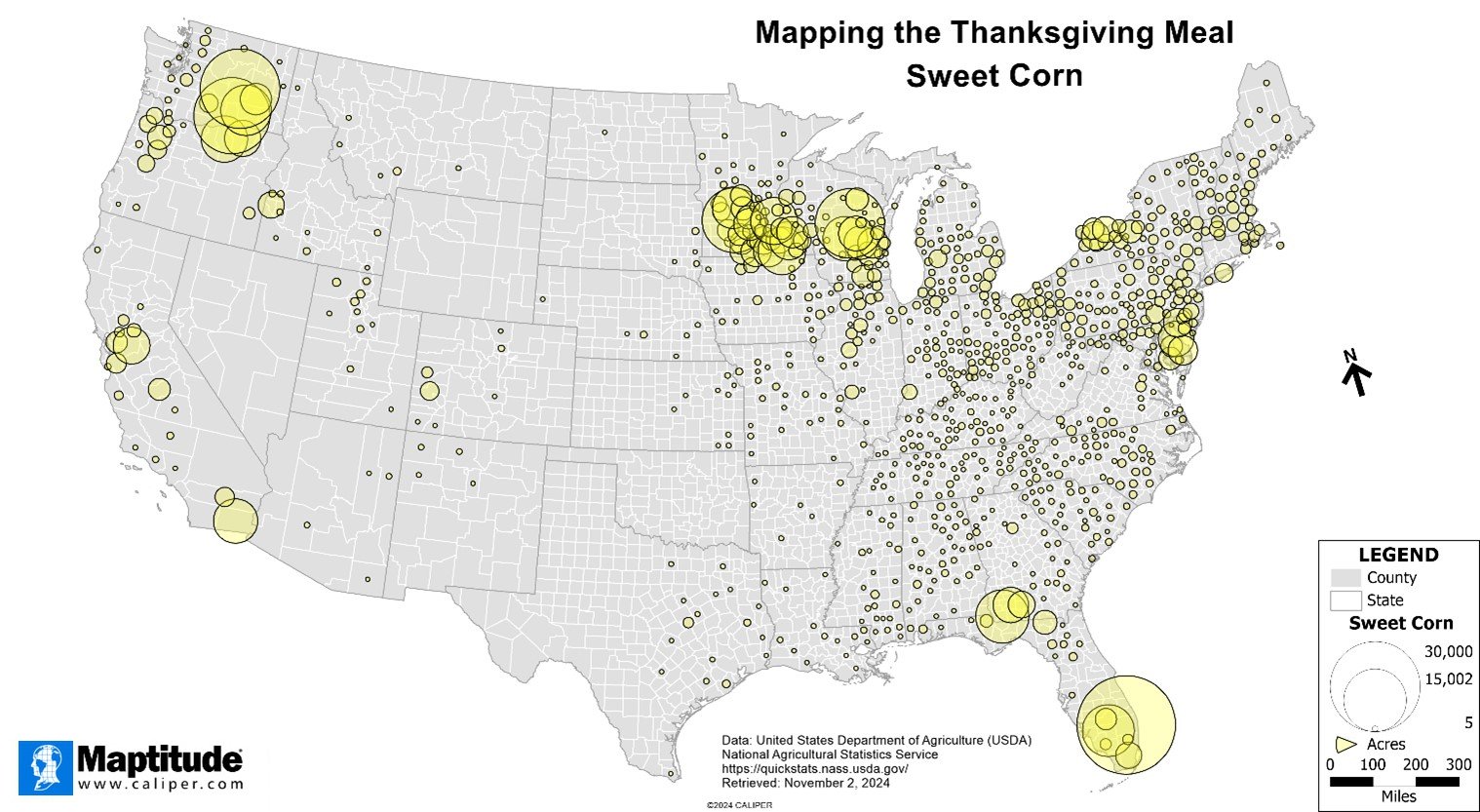
Sweet potatoes became a part of the Thanksgiving meal in the early 20th Century, when Thanksgiving became a national holiday. Sweet potatoes grow best in warm to hot climates, and minimal cold weather or frost threat. The top states for sweet potato production include North Carolina, California, Mississippi, and Louisiana. The map below shows where there are at least 5-acres of land devoted to sweet potato production.
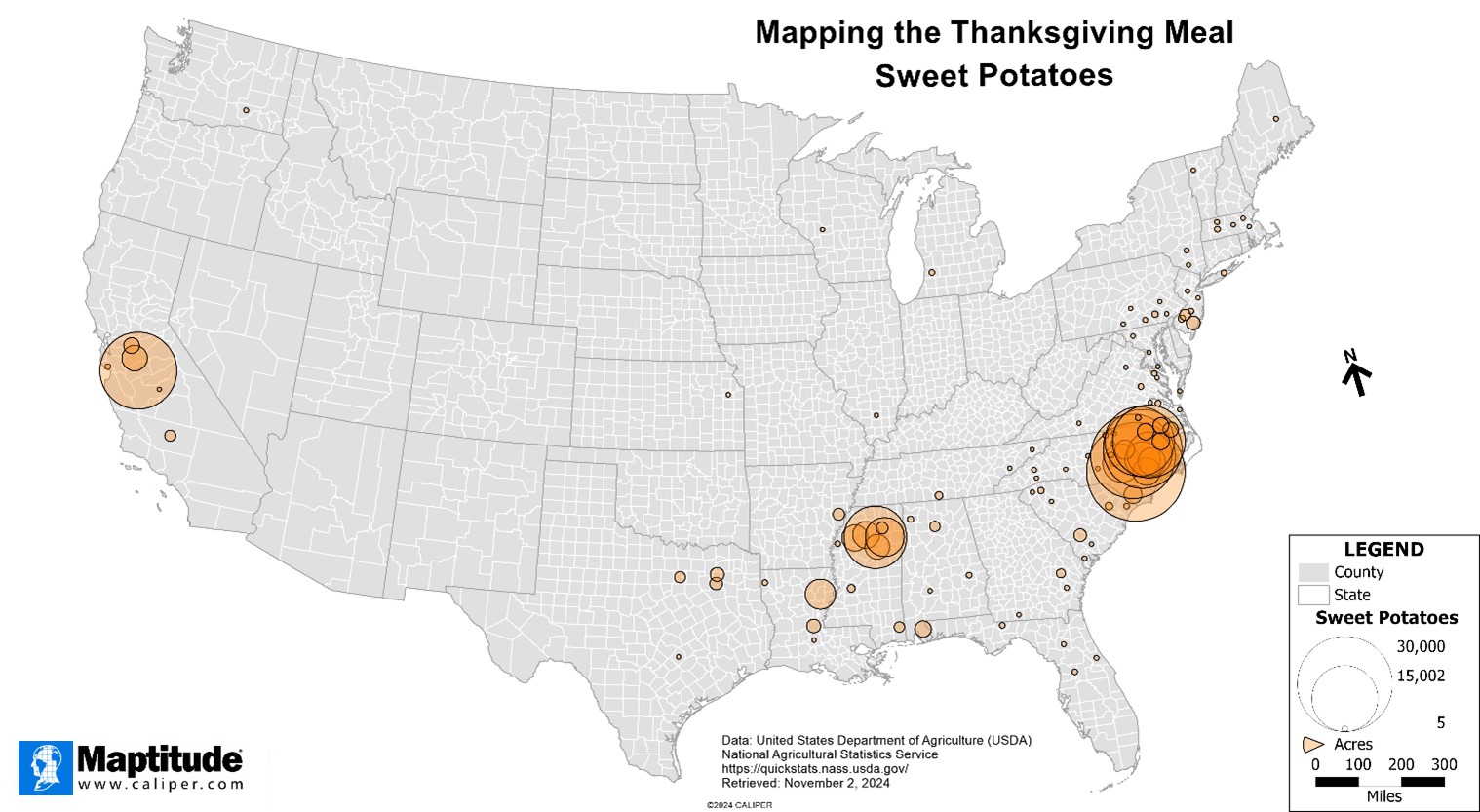
Hopefully the series of maps were enlightening in terms of where the food comes from for the Thanksgiving meal. For each type of food crop, available land, the right soil, and the right climatic growing conditions are key in terms of production.
GIS (Geographic Information Systems) is an important tool in displaying this data spatially, so we as consumers better understand where our food comes from. This includes the agricultural landscape, as well as the transportation landscape to move the crops from farm to market, and eventually to your Thanksgiving table.
Happy eating and have fun exploring with Maptitude!

Home | Products | Contact | Secure Store